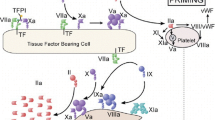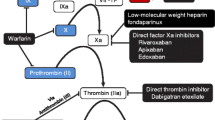Abstract
The REG2 Anticoagulation System consists of pegnivacogin, a subcutaneously administered aptamer factor IXa inhibitor, and its intravenous active control agent, anivamersen. Its effect on thrombin generation is unknown. A prospectively designed thrombin generation study was conducted within the phase 1 ascending dose study of REG2 to assess the effect of REG2 on thrombin generation kinetics. A total of 32 healthy volunteers were recruited into four cohorts of ascending dose pegnivacogin for the phase 1 study. In this pre-specified substudy, blood samples were drawn in the presence or absence of corn trypsin inhibitor at specified times within each dosing cohort. Thrombin generation was initiated with tissue factor and thrombin generation kinetics were measured using the Calibrated Automated Thrombogram (CAT). REG2 attenuated thrombin generation in a dose-dependent manner. All parameters of the CAT assay, except for lag time, showed a dose and concentration-dependent response to pegnivacogin [time to peak thrombin generation (PTm), endogenous thrombin potential, peak thrombin generation, and velocity index (VIx)]. Reversal of the effect of pegnivacogin with anivamersen demonstrated restoration of thrombin generation without rebound effect. This first-in-human study of the effect of the REG2 Anticoagulation System on thrombin generation demonstrates concentration-dependent suppression of thrombin generation that is reversible without rebound effect, as measured by the CAT assay.





Similar content being viewed by others
References
Allen GA, Wolberg AS, Oliver JA, Hoffman M, Roberts HR, Monroe DM (2004) Impact of procoagulant concentration on rate, peak and total thrombin generation in a model system. J Thromb Haemost 2:402–413
Vavalle JP, Rusconi CP, Zelenkofske S, Wargin WA, Alexander JH, Becker RC (2012) A phase 1 ascending dose study of a subcutaneously administered factor IXa inhibitor and its active control agent. J Thromb Haemost 10(7):1303–1311
Hemker HC, Giesen P, Al Dieri R, Regnault V, de Smed E, Wagenvoord R, Lecompte T, Beguin S (2002) The calibrated automated thrombogram (CAT): a universal routine test for hyper- and hypocoagulability. Pathophysiol Haemost Thromb 32:249–253
Luddington R, Baglin T (2004) Clinical measurement of thrombin generation by calibrated automated thrombography requires contact factor inhibition. J Thromb Haemost 2:1954–1959
Povsic TJ, Cohen MG, Chan MY, Zelenkofske SL, Wargin WA, Harrington RA, Alexander JH, Rusconi CP, Becker RC (2011) Dose selection for a direct and selective factor IXa inhibitor and its complementary reversal agent: translating pharmacokinetic and pharmacodynamic properties of the REG1 system to clinical trial design. J Thromb Thrombolysis 32:21–31
Dargaud Y, Beguin S, Lienhart A, Al Dieri R, Trzeciak C, Bordet JC, Hemker HC, Negrier C (2005) Evaluation of thrombin generating capacity in plasma from patients with haemophilia A and B. Thromb Haemost 93:475–480
Brummel KE, Butenas S, Mann KG (1999) An integrated study of fibrinogen during blood coagulation. J Biol Chem 274:22862–22870
Tappenden KA, Gallimore MJ, Evans G, Mackie IJ, Jones DW (2007) Thrombin generation: a comparison of assays using platelet-poor and -rich plasma and whole blood samples from healthy controls and patients with a history of venous thromboembolism. Br J Haematol 139:106–112
van Hylckama Vlieg A, Christiansen SC, Luddington R, Cannegieter SC, Rosendaal FR, Baglin TP (2007) Elevated endogenous thrombin potential is associated with an increased risk of a first deep venous thrombosis but not with the risk of recurrence. Br J Haematol 138:769–774
Tripodi A, Legnani C, Chantarangkul V, Cosmi B, Palareti G, Mannucci PM (2008) High thrombin generation measured in the presence of thrombomodulin is associated with an increased risk of recurrent venous thromboembolism. J Thromb Haemost 6:1327–1333
Hron G, Kollars M, Binder BR, Eichinger S, Kyrle PA (2006) Identification of patients at low risk for recurrent venous thromboembolism by measuring thrombin generation. JAMA 296:397–402
Robert S, Ghiotto J, Pirotte B, David JL, Masereel B, Pochet L, Dogne JM (2009) Is thrombin generation the new rapid, reliable and relevant pharmacological tool for the development of anticoagulant drugs? Pharmacol Res 59:160–166
Cawthern KM, van’t Veer C, Lock JB, DiLorenzo ME, Branda RF, Mann KG (1998) Blood coagulation in hemophilia A and hemophilia C. Blood 91:4581–4592
Dyke CK, Steinhubl SR, Kleiman NS, Cannon RO, Aberle LG, Lin M, Myles SK, Melloni C, Harrington RA, Alexander JH, Becker RC, Rusconi CP (2006) First-in-human experience of an antidote-controlled anticoagulant using RNA aptamer technology: a phase 1a pharmacodynamic evaluation of a drug-antidote pair for the controlled regulation of factor IXa activity. Circulation 114:2490–2497
Chan MY, Cohen MG, Dyke CK, Myles SK, Aberle LG, Lin M, Walder J, Steinhubl SR, Gilchrist IC, Kleiman NS, Vorchheimer DA, Chronos N, Melloni C, Alexander JH, Harrington RA, Tonkens RM, Becker RC, Rusconi CP (2008) Phase 1b randomized study of antidote-controlled modulation of factor IXa activity in patients with stable coronary artery disease. Circulation 117:2865–2874
Chan MY, Rusconi CP, Alexander JH, Tonkens RM, Harrington RA, Becker RC (2008) A randomized, repeat-dose, pharmacodynamic and safety study of an antidote-controlled factor ixa inhibitor. J Thromb Haemost 6:789–796
Brummel KE, Paradis SG, Butenas S, Mann KG (2002) Thrombin functions during tissue factor-induced blood coagulation. Blood 100:148–152
Lawrie AS, Kitchen S, Purdy G, Mackie IJ, Preston FE, Machin SJ (1998) Assessment of actin FS and actin FSL sensitivity to specific clotting factor deficiencies. Clin Lab Haematol 20:179–186
Acknowledgments
This study was funded by Regado Biosciences, Inc.
Conflict of interest
Received research funding from Regado Biosciences, Inc.: R. C. Becker, J. H. Alexander, T. J. Povsic, T. L. Ortel Consultant to Regado Biosciences, Inc.: W. A. Wargin, J. H. Alexander, R. C. Becker Employees of Regado Biosciences, Inc.: S. Zelenkofske, C. P. Rusconi No Disclosures to Report: J. P. Vavalle
Author information
Authors and Affiliations
Corresponding author
Additional information
Dr. Christoph Bode served as the Guest Editor.
Rights and permissions
About this article
Cite this article
Vavalle, J.P., Rusconi, C.P., Zelenkofske, S. et al. The effect of the REG2 Anticoagulation System on thrombin generation kinetics: a pharmacodynamic and pharmacokinetic first-in-human study. J Thromb Thrombolysis 38, 275–284 (2014). https://doi.org/10.1007/s11239-014-1081-6
Published:
Issue Date:
DOI: https://doi.org/10.1007/s11239-014-1081-6




